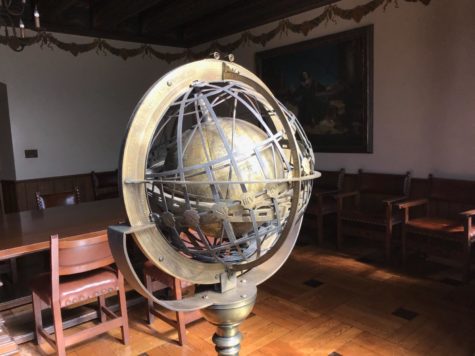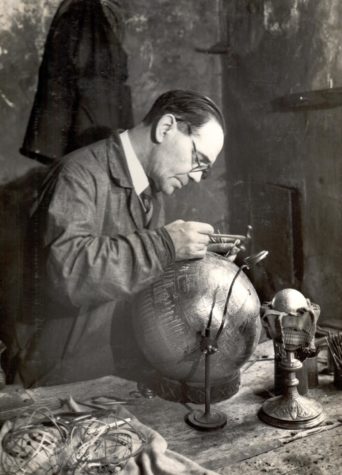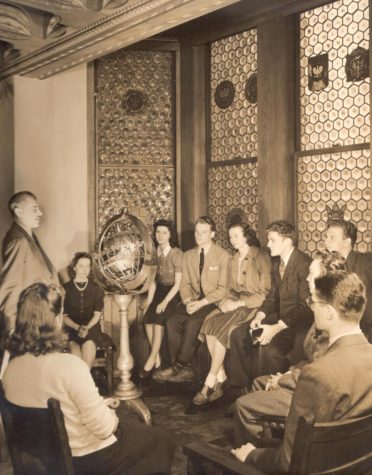Old News: The case of the two Jagiellonian globes
Old News is a bi-weekly blog dragging up ancient Pitt history. Here, we’ll retell some of the weird, interesting or relevant stories we find in The Pitt News’s archives at Documenting Pitt.
More than 1,000 people packed into the Cathedral of Learning Commons Room for the Feb. 16, 1940, dedication of the small Polish Nationality Room on the first floor. A decade of planning had gone into the Polish Room, the ninth of an intended series of 17 Nationality Rooms representing the immigrant communities of Pittsburgh. In addition to connecting the University of Pittsburgh and its City to their roots across the ocean, the Nationality Rooms had the advantage of making the recently built Cathedral even more impressive.
But the idea of the Polish Room had quickly become more important to the Polish and to Polish Americans than it had been before the German invasion of the country in September 1939. Poland itself was now occupied and nearly unrecognizable, already suffering from the immense casualties that would leave it devastated after the war. One sixth of Poland’s population would die over the course of World War II, including 90% of Polish Jews and several million others.
Michael Kwapiszewski, a Polish official who spoke at the dedication ceremony, said soberly that the classroom — as a monument to Polish culture — was of “greater value than could have been foreseen.”
“This room is the continuity of a thousand years of tradition of Polish art and culture,” Kwapiszewski said, according to a Pitt News article from the time. “So long as a nation is not completely destroyed … modern civilization and all the heritage of its arts and sciences will be carried on.”
The Polish Room was patterned after the interiors of Poland’s Wawel Castle, with walnut furniture, a colorful painted ceiling and six-sided “roundel” window panes. A cornerstone from the Collegium Maius, the oldest building at the Jagiellonian University in Krakow, was set in one wall. A copy of Jan Matejko’s painting of the Polish astronomer Copernicus had been hung on the wall, and in front of the room’s bay window stood a recreation of Poland’s 16th-century Jagiellonian globe.

Ruth Crawford Mitchell worked for years to bring copies of Poland’s Jagiellonian Globe and Jan Matejko’s painting of astronomer Nicolaus Copernicus to the new Polish Room.
It was these last two artifacts that had taken on particular importance since the invasion, Kwapiszewski told his audience. The original versions of the globe and the painting, like countless other Polish treasures, had been plundered by the Nazis and taken into Germany, where Nazi leaders were amassing a collection of precious metals, fine art and other items.
The 10-inch-tall Jagiellonian globe especially had long been a point of pride for Poland, and Ruth Crawford Mitchell — the director and powerhouse behind the Nationality Rooms initiative — knew early on she wanted Pitt’s Polish Room to include a replica. Dated to about 1510, the globe was one of the first to depict the Americas, and functioned as a clock and calendar in addition to showing a 16th-century map of the world. In the 1930s, it was on display in the hall of natural sciences at Jagiellonian University.
Getting the replica, however, caused Mitchell considerable grief. A Polish metalworker, Henryk Walden, was contracted in the early 1930s to construct the globe in his Krakow workshop under the supervision of Jagiellonian University professor Tadeusz Estreicher, a world expert on the Jagiellonian globe.

Henryk Walden, a Polish metalworker, spent five years crafting the replica of the Jagiellonian Globe in his Krakow workshop.
The Nationality Room records in Pitt’s University Archives show a seemingly unending stream of letters and telegrams from Mitchell to Walden, Estreicher and a number of Polish government officials aiding in the Polish Room project. Again and again, the craftsman begged for more time, citing the extreme attention to detail necessary to recreate the elaborate globe — four times the size of the original — to Estreicher’s satisfaction.
In the end, Walden took five years to complete the globe at nearly twice the original estimated cost. When it at last arrived in Pittsburgh in 1938, Mitchell and her committee were disappointed that the replica had no mechanism allowing it to function as a clock like the original. Nevertheless, Pitt’s Jagiellonian globe, given pride of place in the room, received rave reviews from Chancellor John Bowen and others in the City.
And at the dedication ceremony, months after the invasion and plundering of Poland, it seemed the model was more than a near-perfect physical recreation of a precious Polish artifact. Pitt’s Jagiellonian globe had new significance now that the original was locked up somewhere in interior Germany, Kwapiszewski said.
But that wasn’t actually true.
The original Jagiellonian globe was safe and sound. As a matter of fact, at the same time Kwapiszewski was in Pittsburgh lamenting its loss, German officials falsely believed Poland had sent the globe to America.
Jadwiga Schoen, a professor at the Jagiellonian University, had been left in charge of the chemistry department after more than a hundred of her male colleagues — including Estreicher, the professor who had overseen Walden’s creation of the replica for Pitt — were rounded up and thrown into German concentration camps. As described by Barbara Rys in a 2011 article for Jagiellonian University’s monthly magazine, Schoen grew concerned for the globe’s safety when a German officer came to the chemistry building to inquire after its whereabouts.
Schoen took the globe from a locked cabinet in Estreicher’s office and brought it to the home of her cousin. Over the next several weeks, Schoen nervously transferred the globe from one house to another, including, at times, her own. When occupying German officials came to ask again where the globe was, she said she wasn’t sure.

A group of Pitt students gather around the Polish Room’s replica of the Jagiellonian Globe, which arrived in 1938.
Then Schoen told them she remembered, all at once, where the globe was. It had been sent to Pittsburgh for display in a Polish Room at a university there.
The officials accepted Schoen’s explanation and moved on to other targets. Schoen and other remaining officials at her university continued to safely guard the original Jagiellonian globe until the end of the war.
Today, the globe is once again on display at Jagiellonian University in the Collegium Maius. Its sister replica is still in Pittsburgh, where the Polish Room, like most of the Nationality Rooms, functions as a University classroom during the week. On the weekends, visitors can rent a key and an audiotape from the Cathedral’s first-floor information center and take a self-guided tour of the set of rooms.
Shortly before the 1940 dedication of the Polish Room, the Pittsburgh Post-Gazette ran a short editorial headlined simply “The Polish Room.” Even while “every weapon of terrorism” was being deployed against Poland in Europe, the piece said, it was important to remember that the Polish wouldn’t be stamped out.
“The latest effort to end Poland as a nation is doomed to failure,” the editorial read. “The Polish Room at the Cathedral of Learning is only one of many reminders of a people which cannot be crushed by oppression.”
Oscar E. Swan, a professor in Pitt’s department of Slavic languages and literatures, translated Rys’ article, which was provided by Maciej Kluza of the Jagiellonian University’s Collegium Maius. Other materials came from the University archives, including archived copies of the The Pitt News, which can be viewed online at Documenting Pitt.
Emily Wolfe is the digital manager at The Pitt News. An Ashburn, Virginia native, Emily plans to graduate in 2022 with majors in fiction writing, French...


